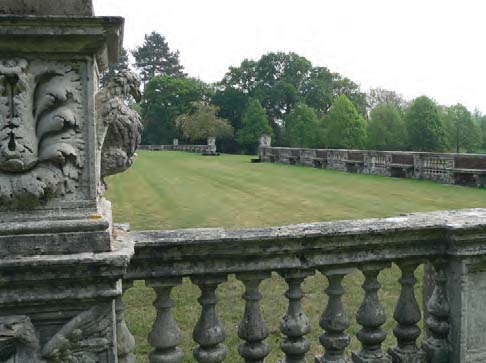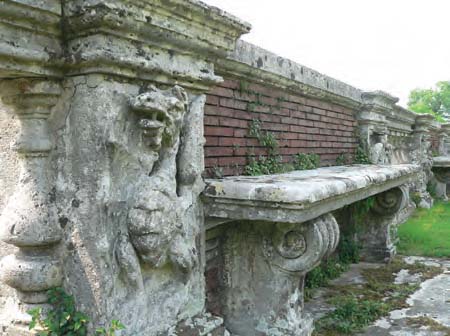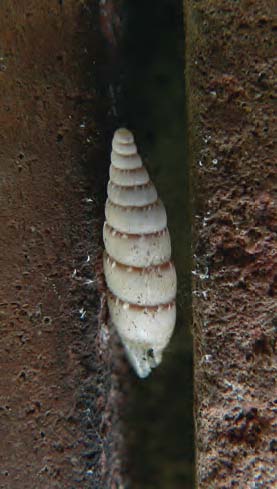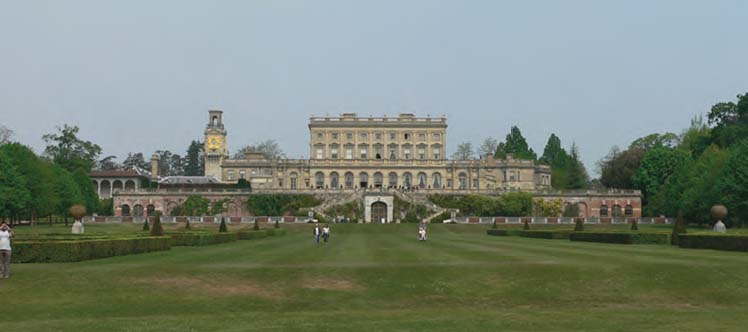|
The article by Alex Menez in the last issue of Mollusc World concerning his finding of the clausiliid snail Papillifera papillaris in Gibraltar, and its ability not only to survive but also to reproduce in captivity in the British climate (Menez, 2007), has prompted me to describe the discovery of a free-living colony of this species at Cliveden in Buckinghamshire. The existence of this colony first came to light in April 2004 after I had given a talk on ‘Shells in archaeology’ to a local amateur archaeological society, in which I mentioned the accidental introduction of land snails into new geographical areas as a result of the movement of people and trade goods. I was approached by a member of the audience, who told me about an ‘unusual’ snail that he had seen while cleaning statuary in the grounds of the nearby country house at Cliveden. This snail looked unlike any British snail that he was familiar with, so I asked him to send me a sample. I recognised the snails as Papillifera papillaris, which I had previously collected at Ostia, near Rome, and my identification was confirmed by Geraldine Holyoak, then the Non-Marine Recorder of the Conchological Society. She deposited two shells as voucher specimens at the Natural History Museum, and the following year the record was briefly published in her annual report in the Journal of Conchology (Holyoak, 2005), although the location was not identified. The species was thus established as a new record for Britain, albeit as a ‘persistent alien’. But what was it doing at Cliveden, and how long had it been there? The present house at Cliveden was built in 1851 by the 2nd Duke of Sutherland and both the house and garden were influenced by the villas of the Italian Renaissance. In 1893 Cliveden was bought by William Waldorf, 1st Viscount Astor, and he continued the Italian theme by filling the garden with classical and Renaissance sculpture. One of these items was the Borghese Balustrade, which extends in two L-shaped sections across the whole of the formal garden below the terrace on the south-facing façade of the house (see photo 1). The balustrade was brought from the Villa Borghese in Rome and set up at Cliveden in 1896. The balustrade itself and its pedestals, which are deeply carved with the dragons and eagles of the House of Borghese, are made from travertine marble, and the sections are linked with brick-tile panels behind the seats (see photo 2). It was carved in 1618-19 for Cardinal Scipione Massimi, one of the greatest art collectors and patrons of Baroque Rome. The house and garden at Cliveden are now owned by the National Trust. Papillifera papillaris was originally found in the crevices and deeply carved details of the marble sections of the Borghese Balustrade. It was not seen anywhere else apart from the balustrade, and the colony was initially estimated to consist of about 100 individuals (Ridout Sharpe, 2005). However, my informant from Cliveden, who worked as a National Trust volunteer in the garden, was only examining the marble sections as he cleaned them. When Tom Walker and I visited Cliveden in November 2005, we were amazed and delighted to find that the snails were abundant all over the balustrade and particularly in the crannies in the brickwork panels where the mortar between the bricks had weathered away (see photo 3). In places, clusters of up to twelve or more snails were nestled deep within these crevices with just the tips of their shells protruding. Most of the snails were adults, but a few half-grown juveniles were also observed. They were more frequent on the north side of the balustrade facing the house, where the brickwork was damper and supported more lichen, but they were found on both sides and on the top (where 29 were counted beneath a loose piece of marble measuring approx. 5 x 10 cm), on the brickwork and on the marble, and they were fairly evenly distributed along the entire length of the balustrade, even including parts where the brick panels had recently been repaired. We estimated an overall population of at least 5000 individuals. We examined the steps and their balustrade leading up to the south terrace of the house (see photo 4) and found a considerable number of Papillifera papillaris. There were fewer crevices here and the snails were clustered under the plants that grew out of some of the cracks. They were not as frequent here as on the Borghese Balustrade, but nevertheless were considered to represent a viable population. Snails were also present on the house-facing north aspect of the balustrade along the terrace, but none was seen on the south face of the house itself. We did find some live snails on the north and west faces of the pavilion at the west end of the terrace, and also a few on the west and east sides of the house: there were no crevices at all here, and the shells were very prominent against the smooth walls. Snail frequency declined sharply with increasing distance from the Borghese Balustrade. We could find no snails on the free-standing statuary and urns elsewhere in the garden. It appears, therefore, that the snails were introduced to Cliveden from Rome on the Borghese Balustrade in 1896. They have established a thriving colony on the balustrade itself, but in over 100 years they have spread only very slowly, and only in the direction of the house. Papillifera papillaris appears to have expanded out of its original distribution range in the central coastal Mediterranean area through its association with man, or rather, its association with the building and ornamental stone that man has exported to other regions. Clausiliids have very limited powers of dispersal, as is evidenced by the virtual restriction of P. papillaris to its balustrade at Cliveden. Wherever it is found outside its original range, it appears to be associated with human occupation, from the importation of marble from Rome to help build Constantinople during the reign of Constantine the Great around AD 330 (Örstan, 2006) to the introduction of garden ornaments to the Garrison Library Gardens in Gibraltar (Menez, 2007) and, indeed, to Cliveden in the 19th century. So limited are its powers of dispersal from these points of introduction, that Örstan (2006) has suggested that a chronology of the dispersion of P. papillaris might be constructed using the known ages of the buildings where it has so far been found. As a result of this method of dispersal, the known distribution of Papillifera papillaris is discontinuous. However, until its discovery at Cliveden, it still appeared to be restricted to the Mediterranean region. Apart from its homeland in mainland Italy and the islands of Corsica, Sardinia, Sicily and Malta, it has been recorded, as an anthropogenic introduction, in mainland France, Spain, North Africa, Greece and Turkey (Mienis and Gümüs, 2007). The discovery of a 100-year-old colony in southeast England represents a big jump from the Mediterranean: are there any other as yet undiscovered colonies in the intervening area, and in Britain itself? A close examination of garden statuary elsewhere may well prove productive. Meanwhile, the National Trust has been appraised of the presence of this attractive little snail in their property at Cliveden, and it is to be hoped that this colony will be conserved for the future, especially with regard to the impending restoration of the Borghese Balustrade. Although global warming is likely to be beneficial to the snail here, at the very far north of its range, because of its limited powers of dispersal it will remain vulnerable. What is amazing is that this colony has already survived in Britain for over 100 years and that, despite the thousands of people who visit Cliveden every year, it had not previously been recorded. Go and look at it, but please, if you must, take only dead shells from the foot of the balustrade. It would be a shame if this colony was to be inadvertently destroyed through the unwelcome attention of shell collectors before its future at Cliveden can be assured. Finally, it should be noted that the nomenclature of Papillifera papillaris is being contested: several authors have advocated the use of the name Papillifera bidens (Linnaeus, 1758) for the same species and an application to the International Commission on Zoological Nomenclature to conserve Müller’s name has not yet been resolved (Mienis and Gümüs, 2007). Watch this space! Acknowledgements My thanks are due to Tom Sutton for drawing my attention to this snail in the first place, to Geraldine Holyoak for confirming my identification, and to Tom Walker for taking me to Cliveden so that I could see it for myself. References Holyoak, g. 2005. Recorder’s report: non-marine Mollusca. Journal of Conchology 38: 722-724. Menez, A. 2007. Papillifera papillaris (Müller, 1774) in Gibraltar. Mollusc World 13: 6-7. Mienis, H.K. and g ümüs, B.A. 2007. More notes on the extra-territorial distribution of Papillifera papillaris, a species often associated with archaeological sites. Archaeo+Malacology Group Newsletter 11: 4-7. Örstan, A. 2006. The clausiliid snail Papillifera papillaris in Istanbul, Turkey. Archaeo+Malacology Group Newsletter 9: 6-7. Ridout Sharpe, j . 2005. Papillifera papillaris (Gastropoda: Clausiliidae): a new record for Britain. Archaeo+Malacology Group Newsletter 7: 6-7. |
Photos: Tom Walker |
Papillifera papillaris (Müller, 1774) in Britain: a giant leap for a small snail
Issue
14
Page
12
Species

 1 The Borghese Balustrade at Cliveden.
1 The Borghese Balustrade at Cliveden. 2 One of the brickwork panels of the Borghese Balustrade.
2 One of the brickwork panels of the Borghese Balustrade. 3 Papillifera papillaris in a crevice in the brickwork.
3 Papillifera papillaris in a crevice in the brickwork. 4 Cliveden House from the south, showing the Borghese Balustrade and the steps leading up to the terrace.
4 Cliveden House from the south, showing the Borghese Balustrade and the steps leading up to the terrace.